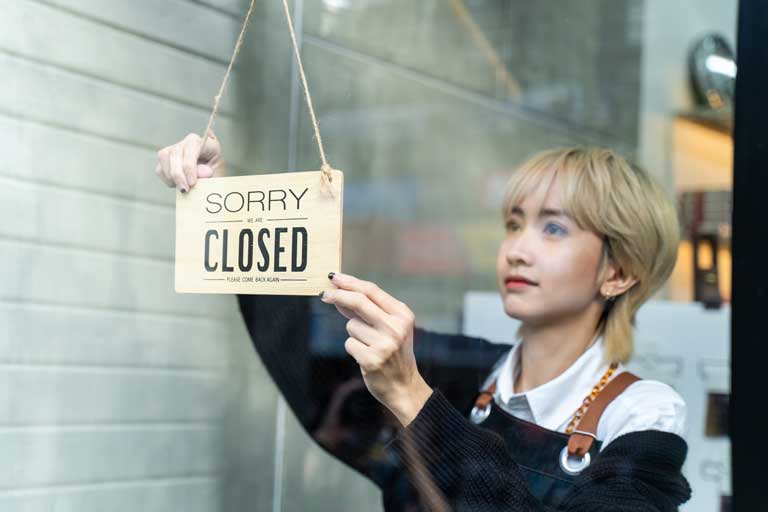Small businesses are currently fighting the market’s heavy inflationary impact. But as we all know, what goes up, must come down. As the old physics saying affirms in terms of gravitational pull, it also rings true for the cycle of economics. When numbers get too high, there will ultimately be a downturn, or in other words, a recession.
Inflation Defined
To simply put it, inflation is the increased cost of goods and services. When prices increase, the dollar’s value decreases along with its purchasing power. The United States federal government measures inflation through the Personal Consumption Expenditures Price and Consumer Price Index (PCE and CPI). An indication of inflation is when consumer overall spending increases over time.
It is standard to see small increments in the cost of living through the years. In fact, a 2% inflation is a healthy diagnosis for the economy. This small rate of inflation supports economic growth and stable employment rates.
Small, steady increments of inflation produce a healthy economy. However, it can have a harsh effect on anyone on a fixed income over the years.
Conversely, if inflation is not kept in check, unhealthy hyperinflation will ensue. Ultimately, hyperinflation has dangerous effects that can be detrimental to the economy’s long-term performance and small business success.
What is the Cause of Inflation?
The economic machine is a constant cycle of highs and lows. However, the lows do grow higher with the expected 2% minimum inflation each year. But what actually causes the economic tides to continually turn?
Credit, debt, interest rates, and supply and demand heavily influence Inflation. Rather than pay off pending debt, human nature influences consumers to continue to borrow credit.
When interest rates are low, consumers take advantage. They purchase goods and property they may not have the available funds for. Because of this, long-term inflation is a constant, gradually decreasing the value of the dollar.
The main cause of price fluctuation is supply and demand. High demand for products with limited availability of supply drives the cost up. Conversely, excess supply with little to no demand sinks prices. The pressure of supply and demand comes from both sides of the equation: the supplier and the consumer.
Demand-Pull
In any healthy economy, small businesses are more profitable. With more profit, there is often an increase in wages. With increased wages, it is less burdensome to spend money.
Therefore, goods and services that consumers may have thought twice about purchasing before, are now seen as more financially accessible. Increased spending yields small business profits and thus the cycle continues.
The rate of demand for the same goods and services increases. However, the rate of production may not be able to keep up. This is demand-pull. When supply cannot keep up with demand, higher prices commence in hopes to quell the over-extended consumer requests.
Cost-Push
Reversely, demand may exceed supply. Not due to a healthy economy, but more so due to a lack of resources to meet consumer needs. A shortage in resources can be caused by labor shortages, natural disasters, pandemics, or even monopolies attempting to control the market.
Cost push is when suppliers are forced to charge more for the same goods. The goal is to slow down the demand for production on items they cannot keep up with.

What Happens During Inflation?
What inflation does to the economy and what the economy does to inflation are two in the same. A healthy economy drives inflation up but extended high inflation induces economic distress. They both cater to a symbiotic cause-and-effect relationship.
Inflation can be positive for economic growth and small business profit. However, if these rises continue above the preferred 2%, the consequences of inflation may be too severe.
Therefore, the central bank steps in to create balance. It attempts to regain control over the economy with the manipulation of the federal reserve rate. The fed rate affects banks’ interest rates, and in return, consumer interest rates reflect the same.
The Impact of Inflation on Small Businesses
Small business owners are the first to experience the economic impact that inflation holds. Because small businesses can be so fragile, they see economic trends and the effects of inflation far sooner than larger corporations.
Recent surveys have shown that inflationary prices have left 75% of small business owners with declines in consumer demand. They agree that inflation has dramatically affected the health of their operation.
Additionally, of the 75%, 62% were forced to increase wages to retain employees during inflation. Furthermore, 43% had to seek out new suppliers to minimize increasing operational costs. Let’s take a deeper dive into the effect on small businesses.
Small Businesses Raise Their Prices
Throughout recent months, we have seen prices rise dramatically on everything. 2022’s wholesale inflation peaked at 11.3%.
Consequently, businesses of all sizes had to compensate by passing these increased fees onto their consumers. The resulting consumer inflation reached a peak of 9.1%. This is the highest inflation rate Americans have experienced since 1988.
Small businesses, however, have to remain careful when it comes to raising product costs. They have to navigate the delicate balance of staying afloat during costly times and maintaining happy and loyal customers. Surveys have concluded that only 53% of small businesses raised their prices this year. What’s more, this increase was less than a mere 10%.

Temporary Spending Increases
Inflation can easily be disguised as an ally in an economic war. With the first sign of rising prices, consumers will jump to make their purchases before the inflation increases further. When prices spike, there is no telling when the costly hurdle will fall.
Because consumers spend more in preparation for the presumably difficult times ahead, merchants can surely benefit from temporary profit increases. Increased spending is, however, short-lived throughout long-term inflation.
Unfortunately, during inflationary times, consumers have depleted bank accounts. When they see increased fees at their local small business, consumers may begin to look into bigger brands for more cost-effective pricing.
In doing so, small businesses lose out on their hard-earned clients to the giants in their industry. This may ultimately impact a small business’s income. Making ends meet becomes a difficult feat and the ability to grow becomes even more challenging.
Increase in Interest Rates
To balance the rate of inflation, the central bank must step in by increasing the fed rate. The increased interest rate decreases the availability of obtainable credit. 2022’s fed rate increases were the first since 2018. Additionally, 2022’s interest rate spikes were the highest America has seen since November of 1994.
According to a recent study, about 39% of small businesses depend on taking out loans to fund their operations. With constrained money supply and loans becoming more expensive, small businesses struggle to produce a profit.
An Influx in the Cost of Living
Small business owners encounter immense pressure when the cost of living goes up. They are expected to keep their product costs affordable for their customers. Meanwhile, they also feel the pressure to increase wage compensation to reflect the rising cost of living. These obstacles can tremendously derail a small business from earning a sustainable profit.
Ultimately, these hurdles make inflation the biggest threat to small businesses today. Small businesses may need to get creative to afford inflation’s added pressures. For example, a recent study indicated that inflation has forced 41% of small businesses to initiate layoffs to stay afloat. Additionally, 39% of small businesses had to take out costly loans to fund their mortgages, rent, supplies, and/or payroll.

Employment Opportunities and Obstacles
Objectively, increased demand will also cause a decline in unemployment. To meet the increased demand, job positions open up. Additionally, profit increases may cause employee requests for higher wages. If a business is seemingly doing well and the cost of living is incrementally increasing, employees may look to their employers for raises.
However, employment opportunities only last so long if inflation is persistent. If the rate of inflation creeps higher than the 2-3% marker, the central bank will compensate with an increased fed rate.
As interest rates rise, money becomes less available. Therefore, the cost of living continues to go up.
Demand for goods and services slows. And employers cannot keep up with paying out increased wages. Small businesses may not be able to keep up during peak inflationary times.
Consequently, employees may look for growth elsewhere, in larger corporations. With a limited workforce, small businesses suffer. Their output is limited and thus, profit decreases.
Rises in Real-Estate
Higher real-estate prices may mean higher rent for most businesses. However, historically, investing in real estate is a great opportunity to hedge inflationary battles. Inflation’s effect on the price of real estate may be a great opportunity for some. Small businesses that either own their physical locations or that deal in the real estate industry can benefit greatly.
If a merchant owns their building at a fixed rate, their mortgage remains the same. Because the dollar value decreases during inflation, paying the same amount means they are actually paying “less” during inflation.
Higher property price tags mean higher sales for small businesses that deal in real estate. For example, entrepreneurs who rent out properties can charge higher rent. Entrepreneurs who work in real estate sales or flips will receive a higher return on their real estate deals.

Seeking Aid From Congress
This Summer, in Washington, D.C., small business owners met with lawmakers during the Goldman Sachs 10,000 Small Business Summit. For the first time in 20 years, the voices of thousands of small businesses are calling to seek congressional action to revitalize the Small Business Administration (SBA).
Small businesses are the backbone of the American economy. They are what drive economic forces of growth and prosperity in every local community. However, outdated SBA policies are hindering small business growth in America.
Revamping the SBA to reflect today’s economy will modernize the marketplace. Allowing the United States to adapt to the post-pandemic landscape. Offering small business owners the support they need to succeed today, is the key to revitalizing America’s economy.
Small business owners are urging Congress to prioritize programs that focus on:
- Workforce competitiveness
- Childcare
- Access to Capital
- Government contracting
- Loan guarantee
- Disaster relief
- Technical assistance
- Entrepreneurial development
- Procurement and contracting assistance
The Impact of a Recession
Early signs of inflation point to a healthy economy. However, prolonged increases in the cost of living can severely threaten the economy.
Demand becomes too aggressive for the available supply. Businesses cannot keep up with demand. Employers cannot keep up with wages. Jobs become at risk. Resulting in a recession as the economic bubble bursts. Recessions erode any signs of economic advancement.
The drop in prices that an initial deflation brings may be beneficial in the short term for consumers. However, with low prices, merchants may find difficulties in yielding any valuable profit. Little to no profit threatens a small business’s ability to grow, hire, and produce.
In a recession, the demand for goods and services is depleted. With businesses losing profit, employers cut wages, or worse, they initiate layoffs. Bank accounts are sparse, and funds for spending are squeezed to essentials only.
Debts become increasingly harder to pay off, loans default, houses are foreclosed on, stock markets crash, and a banking crisis ensues. Ultimately, a recession can disable the entire economic ecosystem.
In 2022’s first quarter, the real gross domestic product (GDP) decreased at an annual rate of 1.6 percent. The second quarter remained negative at 0.9 percent. Economists see the negative GDP as an indicator of an American recession.
A recent study indicated that out of 10,000 small business owners, 93% are concerned about the American economy experiencing a recession in the next year. These business owners are preparing themselves for the challenges this will bring.

Small Businesses Against Inflation Conclusion
Businesses are currently fighting elevated hardships. They are battling the pressures of the rising cost of living, supply shortages, wage demands, and increased loan expenses.
However, through every unanticipated challenge, small business owners remain hopeful. 65% of surveyed entrepreneurs show optimism in the face of the unknown. Regardless of inflation or recession, small business owners see a brighter future. They expect an increased financial trajectory this year for their business endeavors.
The small business community is undoubtedly creative. Moreover, it is remarkably resilient. Not only do entrepreneurs generate new and innovative business endeavors, but they also have no other option than to remain determined to flourish through economic storms.
They face challenges with little to no help and grow amid unforeseen financial difficulties. The heart of an entrepreneur fights for prosperity even when they are battling economic giants.
To contact sales, click HERE. And to learn more about ECS Small Business Payments visit Small Business.
